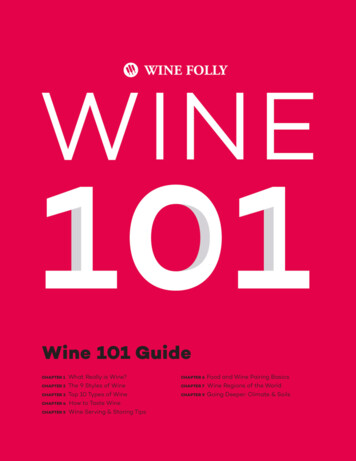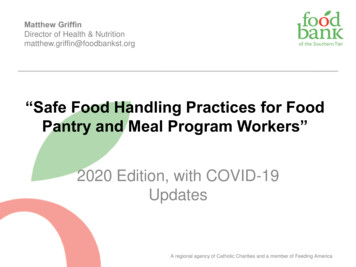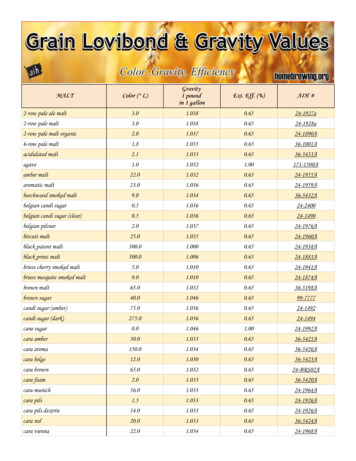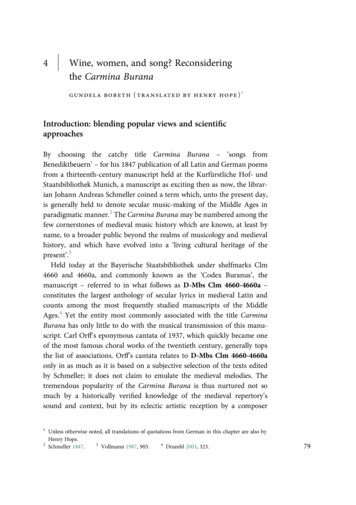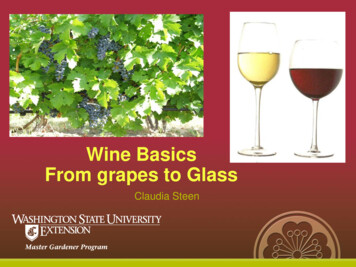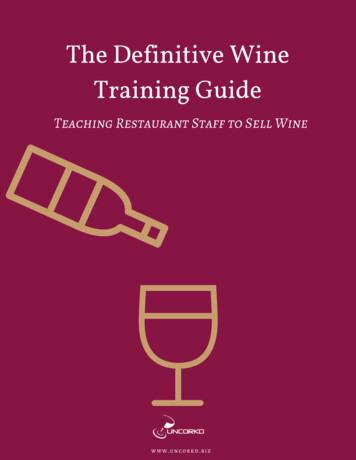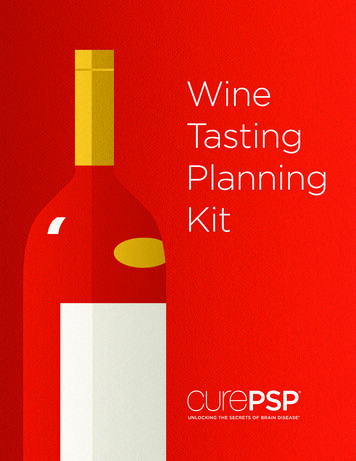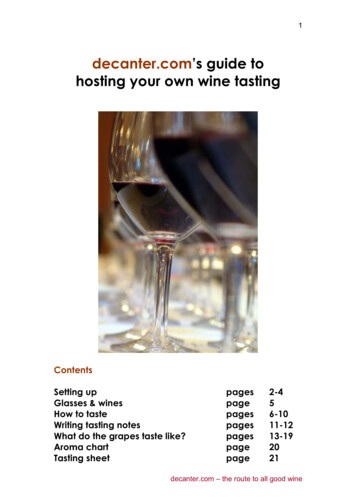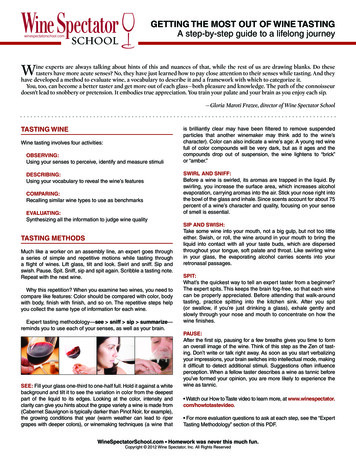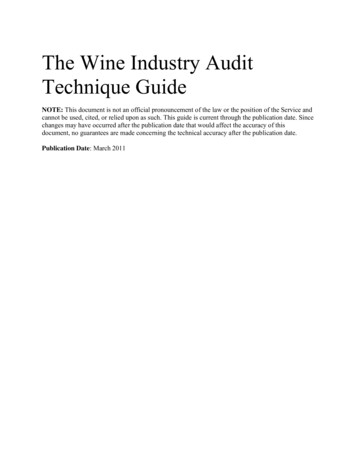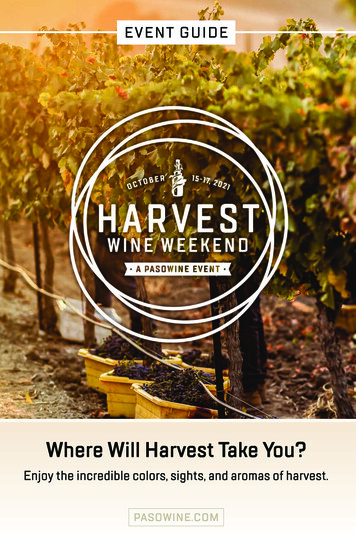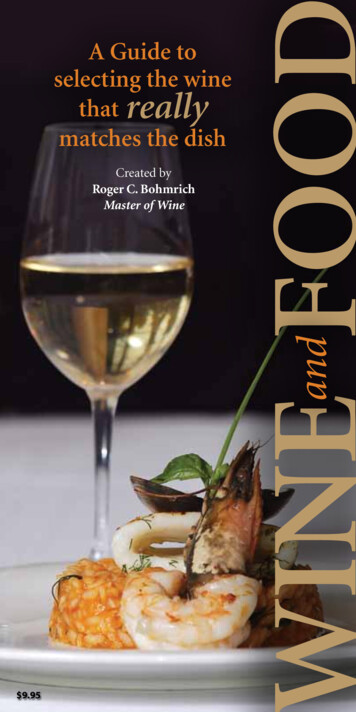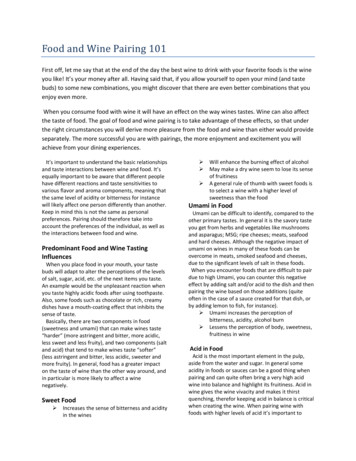
Transcription
Food and Wine Pairing 101First off, let me say that at the end of the day the best wine to drink with your favorite foods is the wineyou like! It’s your money after all. Having said that, if you allow yourself to open your mind (and tastebuds) to some new combinations, you might discover that there are even better combinations that youenjoy even more.When you consume food with wine it will have an effect on the way wines tastes. Wine can also affectthe taste of food. The goal of food and wine pairing is to take advantage of these effects, so that underthe right circumstances you will derive more pleasure from the food and wine than either would provideseparately. The more successful you are with pairings, the more enjoyment and excitement you willachieve from your dining experiences.It’s important to understand the basic relationshipsand taste interactions between wine and food. It’sequally important to be aware that different peoplehave different reactions and taste sensitivities tovarious flavor and aroma components, meaning thatthe same level of acidity or bitterness for instancewill likely affect one person differently than another.Keep in mind this is not the same as personalpreferences. Pairing should therefore take intoaccount the preferences of the individual, as well asthe interactions between food and wine.Predominant Food and Wine TastingInfluencesWhen you place food in your mouth, your tastebuds will adapt to alter the perceptions of the levelsof salt, sugar, acid, etc. of the next items you taste.An example would be the unpleasant reaction whenyou taste highly acidic foods after using toothpaste.Also, some foods such as chocolate or rich, creamydishes have a mouth-coating effect that inhibits thesense of taste.Basically, there are two components in food(sweetness and umami) that can make wines taste“harder” (more astringent and bitter, more acidic,less sweet and less fruity), and two components (saltand acid) that tend to make wines taste “softer”(less astringent and bitter, less acidic, sweeter andmore fruity). In general, food has a greater impacton the taste of wine than the other way around, andin particular is more likely to affect a winenegatively.Sweet Food Increases the sense of bitterness and acidityin the wines Will enhance the burning effect of alcoholMay make a dry wine seem to lose its senseof fruitinessA general rule of thumb with sweet foods isto select a wine with a higher level ofsweetness than the foodUmami in FoodUmami can be difficult to identify, compared to theother primary tastes. In general it is the savory tasteyou get from herbs and vegetables like mushroomsand asparagus; MSG; ripe cheeses; meats, seafoodand hard cheeses. Although the negative impact ofumami on wines in many of these foods can beovercome in meats, smoked seafood and cheeses,due to the significant levels of salt in these foods.When you encounter foods that are difficult to pairdue to high Umami, you can counter this negativeeffect by adding salt and/or acid to the dish and thenpairing the wine based on those additions (quiteoften in the case of a sauce created for that dish, orby adding lemon to fish, for instance). Umami increases the perception ofbitterness, acidity, alcohol burn Lessens the perception of body, sweetness,fruitiness in wineAcid in FoodAcid is the most important element in the pulp,aside from the water and sugar. In general someacidity in foods or sauces can be a good thing whenpairing and can quite often bring a very high acidwine into balance and highlight its fruitiness. Acid inwine gives the wine vivacity and makes it thirstquenching, therefor keeping acid in balance is criticalwhen creating the wine. When pairing wine withfoods with higher levels of acid it’s important to
make sure the wine has a high enough level of acidto avoid making the wine taste languid, flat orflabby. Acid increases the perception of body,sweetness and fruitiness Decreases the perception of acidity in wines Helps make the wine thirst quenchingSaltiness in FoodSalt is a very wine-friendly component which canmellow many of the more difficult and harderelements of a wine. Salt is a great contrast to acidity,which is why, for instance, Asian dishes with a lot ofsoy sauce are a great match with a German Riesling.And of course, many of us love the contrast betweensweet and salty, which is why a great Stilton or BlueCheese matches so well with Port. A great contrast to acidity Decreases the perception of bitterness andacidity in wine Increases the perception of body Works well with sweet winesBitterness in FoodDifferent persons will be affected differently bybitter flavors in both wine and food. In most cases,however, bitter flavors do not pair well with eachother. The level of bitterness in both the food andthe wine may be at favorable levels separately, butwhen consumed together they may combine for anunpleasant taste profile. Bitterness in food increases bitterness inwine. Avoid wines with a high level of hardtanninsChili Heat in FoodAs with bitterness, chili heat in food can affectdifferent people in very different ways. In general,chili heat will increase, in an unpleasant way, thesensations of bitterness, acidity, and alcohol burn.The intensity of this reaction increases as the alcohollevel of the wine increases. The alcohol can alsoincrease the sensation of heat in the food. Chili increases the perception of acid,bitterness, and alcohol burn Decreases the perception of body,sweetness and fruitiness in the wineFlavor ProfileIn general, it’s usually a safe bet to match theflavor intensities of the food and wine to be paired,so that one doesn’t overpower the other. However,in some cases, more intensely flavored foods, suchas a curry, can work well with a lighter style wine,like a slightly fizzy Lambrusco. Many lightly flavoreddesserts can also pair well with intensely sweetdessert wines.Acidity and FatMost people, especially in America, enjoy the pairingof acidic wines with fatty or oily foods. The pairinggives the subjective sensation of the acid cuttingthrough the richness of the food and therebycleansing the palate. Fat also has a way of softeninghighly tannic wines.This is why so many people enjoy a bold Cabernet orSyrah with a grilled rib eye, or a high acid and citrusySauvignon Blanc with many types of white fish.Sweet and SaltyAlthough it doesn’t seem to work technically inwine pairing, who can argue with the wonderful (ifsomewhat subjective) combinations of sweet andsalty? Who doesn’t like a chocolate dipped saltypretzel? A classic example of this would be theEuropean tradition of pairing Stilton cheese withPort.GeographyAll things being equal – if you find a suitable pairingfor your dish and you can source it from the samegeographical area, you can discover some verywonderful and fun combinations, that also quiteoften are accompanied by some interesting storiesand history.Difficult Foods to Pair Sweet – foods or dishes high in sugarshould be paired with wines that havesweetness levels as high or higher than thefoodUmami – fruity wines or wines with lower,softer tannin levels pair more favorablywith dishes higher in umami as the umamibrings out the bitterness of the tannins inthe wine. High levels of umami can bebalanced out by the addition of salt or acid
to a dish, but the addition shouldn’t changethe basic character of the foodsBitterness – in food will emphasizebitterness in the wine. Match bitter foodswith white or neutral wines, or reds withlower levels of tanninChili Heat - pair with white wines, slightlysweet whites and reds, or low-tannin reds.Low alcohol wines are better, as the chiliheat accentuates the alcohol burn andbitterness for many people. Chili alsoreduces fruitiness or sweetness, so look forwines that are higher in these properties. Wine Friendly Foods Foods higher in acid and/or salt tend to beeasier to match with most wines; keeping inmind that foods high in acid should bematched with a wine with a higher acidlevel, or the wine may taste too soft orflabby.Challenging WinesThe more structural components in the wine and/orfood to be paired, the more challenging, but alsorewarding, the pairing can become. The mostdifficult wines are those with higher levels ofbitterness from oak or tannins and/or high levels ofalcohol and/or acid. The good news is that if you finda suitable pairing the wine can reveal complexitiesand flavors that might not be detected if the winewere to be drunk without food.Lower Risk WinesNeutral, unoaked wines with a small amount ofresidual sugar can be pretty safe with most foods,but also aren’t likely to produce very interestingexperiences.Other ConsiderationsNotwithstanding all the guidelines for food and winepairing, people who have the most frequent successtend to be those who rely mainly on their instinctsand experience. Some simple concepts to consider: Pair great with great and simple withsimple. A basic meatloaf sandwich doesn’tneed an expensive merlot to make a nicecombination. On the other hand, anexpensive crown roast of lamb or prime ribmay be the perfect occasion for breaking out that big and opulent Napa Cabernet orBordeaux you’ve been saving.Match delicate to delicate and bold to bold.A delicate red Burgundy or most anydelicate white will be completelyovershadowed by robust or spicy dishes.Likewise, bold, spicy and hot flavors workwell with spicy, big flavored, lower tanninwines such as Zinfandel.You can choose to mirror the wine to thedish, or set up a contrast, either can work.For instance: a California Chardonnay withlobster or pasta in cream sauce would be anexample of mirroring. Or, you can servethat same dish with a crisp, sharp, bubblingChampagne.Think flexibility: Oaky Chardonnay is a verypopular varietal, but it is one of the leastflexible white wines to pair with mostfoods. Sauvignon Blanc, dry Riesling fromGermany or Alsace, or a more neutral winelike Pinot Grigio offer much more flexibility.More flexible red wines either have niceacidity, such as Chianti, red Burgundy andAmerican Pinot Noir; or they are fruity withmoderate or low tannins, such as Zinfandel,simpler Italian reds and southern Rhonewines.ConclusionA couple of good ways to produce interesting andsatisfying combinations are to use these principals topractice your own pairings, and make notes of whatworks and what doesn’t. Another way is to takenotice of long established successful pairings and tryto identify which of these principals are at workthere, and use those same ideas when creating yourown pairings. Also, consider what exactly you’retrying to pair the wine with when you have a dishwith many different flavor profiles going on at thesame time. Are you trying to match the protein, thesauce, the vegetable, etc. In general, the simpler thebetter.At the end of the day, the wines that appeal most toyou at any given times are always a good choice;however, we feel that by practicing these principalsover a period of time you will begin to discover newwine and food experiences that are even moreappealing to you and your guests.
SIGNIFICANT RED VARIETALSCabernet Sauvignon (Cab-er-nay Saw-vee-nyon)Cabernet is a complex and full-bodied wine characterized by aromas of black currants, blackberries, black cherries,plums, cedar, mint, clove, and strong hints of vanilla oak. “Cab” is intensely flavorful, and is more acidic and hasharder tannins than Merlot.Merlot (Mer-loe)Merlot is fruit-intensive and has softer and more velvety tannins than Cabernet. Merlot is characterized by blackcherries, red cherries, and oak flavors. In Bordeaux Merlot is almost always blended with Cabernet Sauvignon orCabernet Franc.Pinot Noir (Pee-noh Nwahr)Pinot Noir is complex, having a velvety texture, majestic flavor, and is extraordinary in bouquet. Pinot Noir issophisticated and has rich, fruit flavors of black cherries, blackberries, and plums as well as dried roses, tar, bark,earthy mushrooms, cola, and spicy black pepper. Pinot has a higher level of acid, which makes it a more flexiblefood pairing wine.Zinfandel (Zin-fan-dell)Zinfandel is a full-bodied, spicy wine with strong raspberry, blackberry, boysenberry, cranberry, and black cherryflavors, as well as hints of licorice, black pepper, plum, tobacco, cedar, vanilla, and light oak.Syrah/Shiraz (France/Australia) (Seerah/Shur-oz)This wine is deeply colorful, powerful, peppery, spicy, and is characterized by black cherry, blackberry, tar, clove,thyme, leather, and roasted nut flavors. This wine exhibits a rich, smooth, supple texture, and even tannins.Sangiovese (San-joe-vae-sae) – Predominantly ITALYMedium-to-full-bodied wine with supple “warm” texture. Sangiovese boasts the flavors of raspberries, cherries,anise, and various spices. It is the varietal used to make Chianti.
SIGNIFICANT WHITE VARIETALSChardonnay (Shar-doh-nay)At its best, Chardonnay features bold, rich fruit flavors of apple, fig, melon, pear, peach, pineapple, and citrusfruits. It also may possess hints of honey, butter, vanilla, butterscotch, and hazelnut. Most significantly, as a resultof oak-barrel aging, Chardonnay is well known for its flavors of apple, vanilla, and toasty oak.Sauvignon Blanc (Saw-vee-nyon Blahnk)Sauvignon Blanc is brisk, strong, dry, and light-bodied, and features citrus, grassy, and floral scents. MostSauvignon Blanc wines are dry and “un-oaked” (fermented in steel vats instead of oak barrels), with a bracing,lively acidity that balances the wine’s natural fruitiness.Chenin Blanc (Shen-in Blahnk)Chenin Blanc’s signature is its acidity combined with high alcohol content and a full-bodied, almost oily texture.Though Chenin Blanc is most often found in simple, dry wines, it can - especially in the Loire Valley - create greatwines in a variety of styles from dry to sweet. It has a subtle fruitiness (melon, peach, quince, apricot, andsometimes even a citrus quality.) It can also have spicy overtones together with a smooth hint of honey.Gewurztraminer (Geh-Vairtz-trah-mee-ner)Full-bodied and flamboyant, Gewurztraminer wines are invariably deeply flavored, aromatic wines. Their flavor issomewhat exotic with a bit of apricots and grapefruits, floral roses, and herbal spices such as tarragon. Still, theyare dry, refreshing wines that couple extremely well with food.Riesling (Rees-ling)These are light-bodied, medium-dry, low-alcohol wines, often with lively acidity and crispness. A good Riesling hasa distinctive floral or honeysuckle aroma with citrus fruits, peaches, and apples. For the most part, Rieslings shouldnot be aged. They should be consumed fresh and young.Pinot Grigio (Pee-noh Gree-joe)
Pinot Grigio wines are medium-to-full-bodied, lightly fruity, somewhat peachy, with slight hints of grass and spice.Some Basic Wine and Food PairingsAsian Cuisine (umami) – Grüner Veltiner, Riesling, Sauvignon Blanc, Gamay, Pinot NoirCaviar, Oysters, Smoked Salmon – Champagne or Dry Sparkling WineOlives, Almonds, Canapes, etc. – Sauvignon Blanc, Cava, Albarino, Chablis, Dry Sherry, BlushWineCream Soups – White wineHeavy Vegetable Soups – Lighter Red WineBarbeque Ribs & Chicken - Pinot Noir, Zinfandel, Rhone Wines, Carmenère, Lower Price RedBlends in GeneralFried Foods – Sparkling Wines such as: Cava, Champagne, Crémant, Moscato d’ Asti, ProseccoFish: Poached, Grilled or Sautéed; Crab or Lobster – Chardonnay (Chablis), Sauvignon Blanc,Riesling, Soave, Verdejo from SpainMore complex Fish or Shellfish dishes – Champagne, Riesling, Soave, Chardonnay (Chablis),Gewurztraminer, Vermentino from Italy, Fino Sherry, Pinot NoirChicken or Turkey –Barbera, Dolcetto, Chardonnay,Torrontes from Argentina, Dry RosePheasant – Champagne, Viognier, Mature Pinot NoirRoast Ham or Pork – Gewurztraminer, Viognier, Blush wine, Beaujolais, Dolcetto from ItalyLamb – Fine Red Bordeaux, Cabernet SauvignonBeef – Merlot, Beaujolais, Cabernet Sauvignon, Dry Italian Red Wines (Nebbiolo), Syrah, PetiteSyrah, TempranilloMediterranean (salty, oily dishes) – Assyrtiko, Carricante, Pinot Grigio, Vermentino, Cotes deProvenceTomato Based Pizza & Pasta – Barbera, Corvina, Lambrusco, Nebbiolo, Sangiovese
Stews or Pot Roast – Beaujolais, Cabernet Sauvignon, Zinfandel, Pinot Noir, Basic SangioveseSalads – Chenin Blanc, French Colombard, Sauvignon Blanc, Assyrtiko from GreeceCheese – Full-bodied Red Wine, Big Bordeaux, Cabernet Sauvignon, Pinot Noir, Chardonnay,Sauvignon Blanc, Fume Blanc, PortDesserts – Any Sweet or Sparkling WineGalloway Culinary
Food and Wine Pairing 101 First off, let me say that at the end of the day the best wine to drink with your favorite foods is the wine you like! It’s your money after all. Having said that, if you allow yourself to open your mind (and taste buds) to some new combinations, you might
